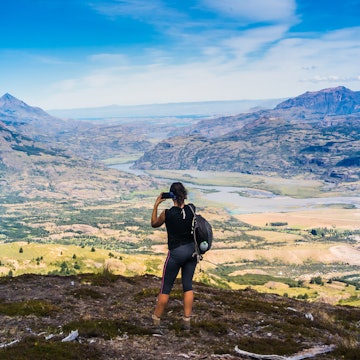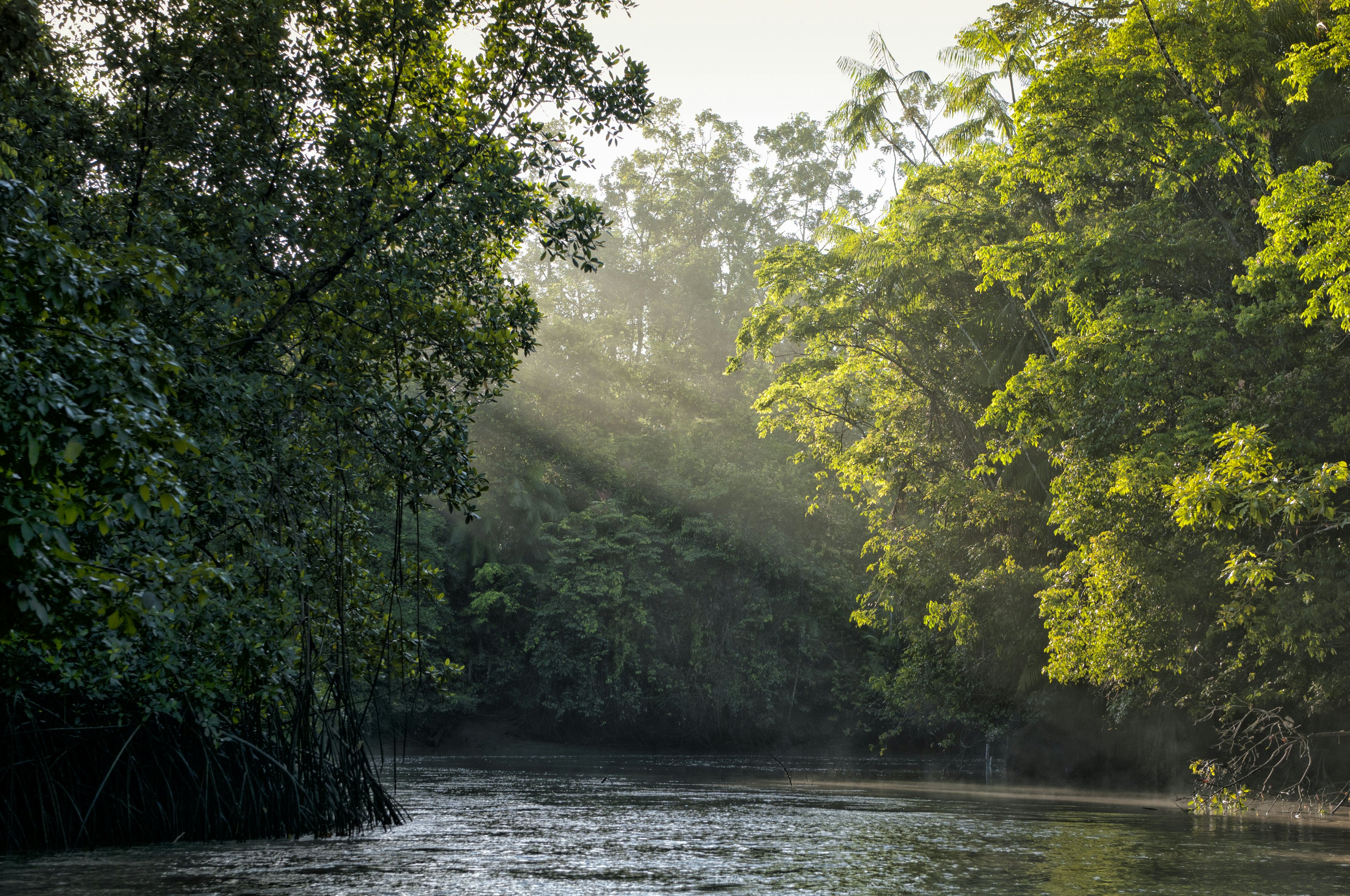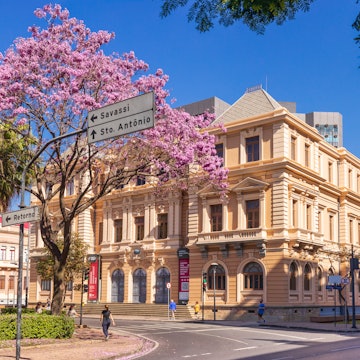

Fernando de Noronha. jp_vizintim/Shutterstock
One of the world’s most dazzling destinations, Brazil is packed with steamy rainforests, tropical savannas and expansive wetlands. The ecosystems in this giant of South America are home to the largest collection of plant and animal species anywhere on earth.
But even if exploring the natural world is not top of your Brazil to-do list, there's plenty of life in the country’s musical metropolises.
When it comes to relaxing, Brazil has sand to spare: 2095 beaches, to be precise, dot its 7242km Atlantic coastline.
With such a massive footprint and variety of things to do, planning a visit here can feel overwhelming. Get started with our 10 favorite places to visit in Brazil.

1. Ouro Preto and the towns of Minas Gerais
Best for gold rush history
Ouro Preto (meaning “Black Gold”) in Minas Gerais was at the heart of Brazil’s 18th-century gold rush.
Nearly two dozen churches, lavishly ornamented with gold filigree, still ring out their bells across the hillsides of this rural town, which at its height had 110,000 residents – the majority of whom were enslaved people.
One of Ouro Preto’s most famous residents was the sculptor Aleijadinho, who studied European baroque traditions and developed his own unique style.
His sculptures and reliefs – some of which he carved after losing his fingers to a disease – adorn churches across the region, including in Tiradentes, Congonhas and São João del Rei.
Detour: The historic Royal Road links up most of these towns and makes for an adventurous road trip. An essential stop for art lovers is the world’s largest open-air contemporary art museum in Inhotim.

2. Paraty and the Saco de Mamanguá
Best for artists and literary lovers
The other terminus of the Royal Road, seaside Paraty was where the precious metals extracted from Minas Gerais were shipped out in the early days of Brazil’s gold rush.
The town lost some of this export trade to Rio de Janeiro in the early 1700s, yet its architecture was impeccably preserved – and it’s all the more impressive for being sandwiched between steep, jungle-covered mountains and the warm, clear waters of the ocean.
Forgotten for centuries, Paraty has in recent decades attracted writers and artists from all over the world. The city hosts a number of prestigious events, including the literary festival Flip, a jazz festival and a pinga festival (pinga is slang for cachaça, the Brazilian cane spirit that’s produced locally).
Planning tip: Getting out on the water to explore some of Paraty’s 65 islands and 300 beaches is a must. Motorboats and schooners can be rented, but for a close-up connection with nature join a kayak tour in the fjord-shaped Saco de Mamanguá and paddle to deserted beaches, mangroves, waterfalls and the local Caiçara fishing communities.

3. Amazon rainforest
Best for forest adventures
The Amazon has a mysterious pull that has fascinated people for centuries. One of the wildest places on the planet, the region is almost too big to comprehend, spanning about 42% of Brazil and swaths of eight neighboring countries.
Each area offers something different in terms of ecology, tourism and local culture; research before visiting is essential as it’s neither a budget-friendly nor easy-to-reach destination.
You'll gaze at the unending expanse of green for hours as you fly overhead into Manaus, the region’s largest city and a good jumping-off point for many of the lodges and Amazon experiences.
You can try canoeing through flooded forests at Parque Nacional de Anavilhanas, heading further afield to the recently formed Xixuaú reserve or spotting river dolphins in the Mamirauá reserve.
Detour: A few hundred miles east, Santarém is another access point for seeing the majestic trees deep in the Tapajós forest or beach hopping along the banks of the Rio Arapiuns, a tributary of the Tapajós near Alter do Chão.

4. Brasília
Best for modern architecture
The city of the future that’s forever stuck in the past, Brasília is a fabulous paradox. The federal capital officially opened for business in 1960, becoming the ultimate symbol of modernity for an urbanizing nation and a long hoped for kick start for the economic development of the country’s interior.
Built in the middle of the hot, dry landscape of Brazil’s Center West, Brasília is an open-air monument to the people who shaped and built it, including urban planner Lúcio Costa and architect Oscar Niemeyer, whose much-loved curves can be spotted everywhere, most notably at the cathedral. Its white columns rise to the heavens in a hyperboloid structure studded with stained glass.
Planning tip: Thousands of tons of concrete and steel were poured into a series of modernist architectural gems that are worth spending a day or two to explore – though not on foot, as the sprawling city was designed for cars, not pedestrians.

5. Jalapão
Best for swimming and hiking
In a country teeming with rainforests, pristine beaches and other natural wonders, the tropical hinterlands of the cerrado (savanna) certainly holds its own.
While the cerrado has borne the brunt of Brazil’s agribusiness boom in recent decades, pockets of conservation do exist, including the relatively unexplored Parque Estadual do Jalapão's 34,000 sq km of scrubland, grasslands, forest, caves and unusual rock formations.
The best time to visit is the dry season (from May to September) when, despite the dry landscape, water is the main attraction, so you can splash in the glassy pools of waterfalls or kayak down rapids.
You can also take a dip in the fervedouros (boiling pots), natural springs where bubbling water buoys swimmers. Sand dunes and chapadas (mountain formations) also make for some spectacular hiking.
Detour: Parque Nacional da Chapada dos Veadeiros (400km south) and Parque Nacional das Emas (to the west) are two much larger conservation areas that are home to dozens of species of flora and fauna at risk of extinction. Lucky hikers might cross paths with giant anteaters, giant armadillos, maned wolves and rheas, South America’s largest bird.

6. Pantanal
Best for spotting wildlife
The largest wetland region in the world, the Pantanal offers the best wildlife spotting in Brazil. South America’s largest mammal (the tapir) and largest bird (the rhea) live in the Pantanal, as do more than 230 species of fish and 650 species of birds – plus such apex predators as jaguars, caimans and anacondas.
It’s easier to spot wildlife during the dry season, from May to September. When the water levels rise from October onward, the rivers flood their banks and inundate the surrounding plains, spurring an abundance of flora and flocks of wading birds.
The wet season also brings the arrival of river cruises: the sundeck of a 15-cabin boat cruise to the Serra do Amolar mountains near the border with Bolivia is an ideal vantage point from which to contemplate the grandeur.
Planning tip: Spanning an area more than half the size of France, the Pantanal can be explored in a number of ways. The most accessible is by road, on the Estrada Transpantaneira, though small airplanes and motorboats open up more remote zones and secluded, upscale lodges.

7. Fernando de Noronha
Best for honeymooners
An archipelago some 320km off the northeast coast, Fernando de Noronha is high on many honeymoon wish lists.
Of Noronha’s 21 islands, only the largest one is accessible to tourists – and even then, its boundaries lie safely within Brazil’s largest marine park.
Dreamy beaches – including Baía do Sancho, Baía dos Porcos and Praia do Leão – compete for the top slot on rankings of the best beaches in the country.
Silky soft sands and clear blue waters would have holidaymakers flocking here if this place were on the mainland; happily, its remote location and a cap on visitor numbers keep the crowds to a welcome minimum.
Just offshore, Noronha is an underwater paradise: 230 fish species, 15 varieties of coral, five types of (harmless) sharks and the greatest concentration of tropical marine birds in the Atlantic.
You can dive to spot coral and shipwrecks in the marine park, or watch hundreds of dolphins doing water acrobatics at sunrise before snorkeling in shallow tide pools. Noronha offers Brazil’s natural beauty at its absolute best, and this place warrants going the extra mile.

8. Rio de Janeiro
Best for culture and beaches
The most-visited city in Brazil, Rio de Janeiro didn’t earn its title of cidade maravilhosa (meaning “marvelous city”) for nothing. In the eyes of cariocas (residents of Rio), it’s the most beautiful place on earth. Visitors would be hard-pressed to disagree.
Dense high-rises are stacked like sugar cubes between mountains cloaked in rainforest and studded with naked granite peaks jutting skyward.
A wealth of sights highlight the city's culture and history (it was the capital of the Kingdom of Portugal in the 19th century and, until 1960, the capital of Brazil).
Visitors hit the famous beaches to lounge in the sun, but the locals go to get active – surfing, running, cycling or diving into the sand over a sweaty game of beach volleyball. People watching is a serious beach sport in its own right.
Come evening, Rio’s special blend of tropical rhythms draws crowds onto the city’s streets to meet friends at botecos (bars) or to join impromptu street parties.
Planning tip: Bike Itaú offers more than 5000 bright orange bicycles around the city, with dedicated bike lanes along the beachfront

9. Ribeira Valley and the Mata Atlântica
Best for pristine nature
The Mata Atlântica (Atlantic rainforest) is Brazil’s other tropical forest. Regrettably, it’s also one of the most endangered biomes in the world, with just 12.5% of it remaining in disparate fragments along Brazil’s southeast-facing coastline.
The forest has a wider variety of flora and fauna per hectare than the Amazon, with half of its species not found anywhere else in the world.
The Ribeira Valley – a 28,489-sq-km river valley straddling the border between the states of São Paulo and Paraná – is the largest continuous stretch of the remaining Mata Atlântica.
Visitors can explore some of the biggest caves in Brazil (at Parque Estadual do Alto do Ribeira), stay at traditional quilombos (communities that were formed by escaped enslaved Africans), hike through the forest and raft down rivers.
Private nature reserves, like the whopping 310-sq-km Legado das Águas, offer a range of ecotourism activities.
Planning tip: An ambitious plan to connect conservation areas (including the Ribeira Valley) with one long trail – the Caminho da Mata Atlântica – has been gathering pace, though no one has yet attempted to hike its full 4000km length.

10. São Paulo
Best for a lively city break
South America’s most populous city, São Paulo may not have beaches, vast swaths of forest or even clean rivers, but it has a kinetic charm all of its own.
Poet Mário de Andrade called it “the hallucinated city,” which seems a fitting description for a megalopolis of 20 million residents.
It’s a city whose soul is young and restless, a party-mad colossus with cutting-edge theaters, world-class chefs and a fascinating art scene, among countless other draws.
With layer upon layer of immigrant influences and centuries’ worth of boom-and-bust cycles, São Paulo attracts people from all over the world who thrive on its energy. Its delights are not served up on a plate – visitors have to seek them out. But once you get a taste, you'll be hooked.














